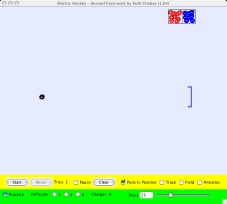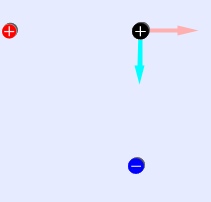
Teaching Physics with the Physics Suite
Edward F. Redish
Home | Action Research Kit| Sample Problems | Resources | Product Information
Problems Sorted by Type | Problems Sorted by Subject | Problems Sorted by Chapter in UP
 |
Teaching Physics with the Physics Suite Edward F. Redish Home | Action Research Kit| Sample Problems | Resources | Product Information |
Problems Sorted by Type | Problems Sorted by Subject | Problems Sorted by Chapter in UP |
Launch the program Electric Field Hockey. The screen should look like the figure shown at the right. Be sure the check boxes in the control bars at the bottom of the screen are set as follows: In the yellow bar:
|
 |
a. To see how this works, use the mouse to take a negative charge from the cache of charges and place it behind (to the right of) the goal. Press start to see what happens.
Hit the reset button and try to place a single positive charge so that it drives the test charge into the goal. Once you have done this, reset and turn on Trace, Field, and Antialias in the yellow bar. Run the simulation by pressing start and print your result.
b. Reset (keeping in practice mode and turning off Trace, Field, and Antialias) and place a positive (red) source charge directly to the left of the test charge (black) and at the edge of the screen. The program will display a small red arrow showing the force the red charge exerts on the test charge. Then place a negative (blue) source charge directly below the test charge so that it is at about the same distance from the test charge as the positive charge. The program will show you a blue arrow showing the force the blue charge exerts on the test charge. In what direction will the test charge start moving? Why? |
 |
Now turn on Trace, Field, and Antialias (this makes the field vectors easier to see) and Start. Only pay attention to the path that the test charge follows until it leaves the screen. Print your result.
(The situation we are studying -- two fixed sources of force and a particle moving under their influence -- is called a restricted three-body problem. Problems of this type can almost never be solved in terms of formulas and often show extreme sensitivity to the starting conditions known as chaos.)
As the particle moves under the influence of the forces of the two charges, does it move in the direction of the E-field at the point where it is? That is, do the E-field vectors point along the path the particle follows? If so, explain why. If not, explain why not.
c. Reset the program and click on difficulty level 2. Put down source charges until you can get a path that leads you to your goal. Print the result with Trace, Field, and Antialias turned on and include the figure in your homework. Describe how you found your solution. Did you find it more effective to have Field turned on or off in your search? Explain why.
* Electric Field Hockey was created by Ruth Chabay and ran on 1990's computers. (It is still available from Physics Academic Softeware.) A modern Java version has been created by the PhET group at the University of Colorado and is available on the PhET website. It is the latter version we are using here.
Not finding what you wanted? Check the Site Map for more information.
Page last modified February 19, 2008: E43